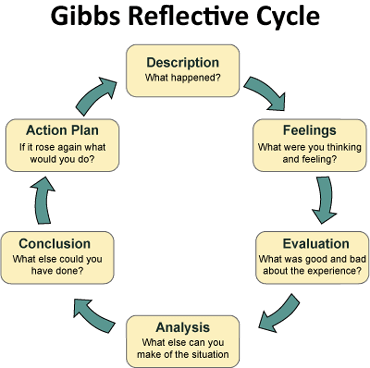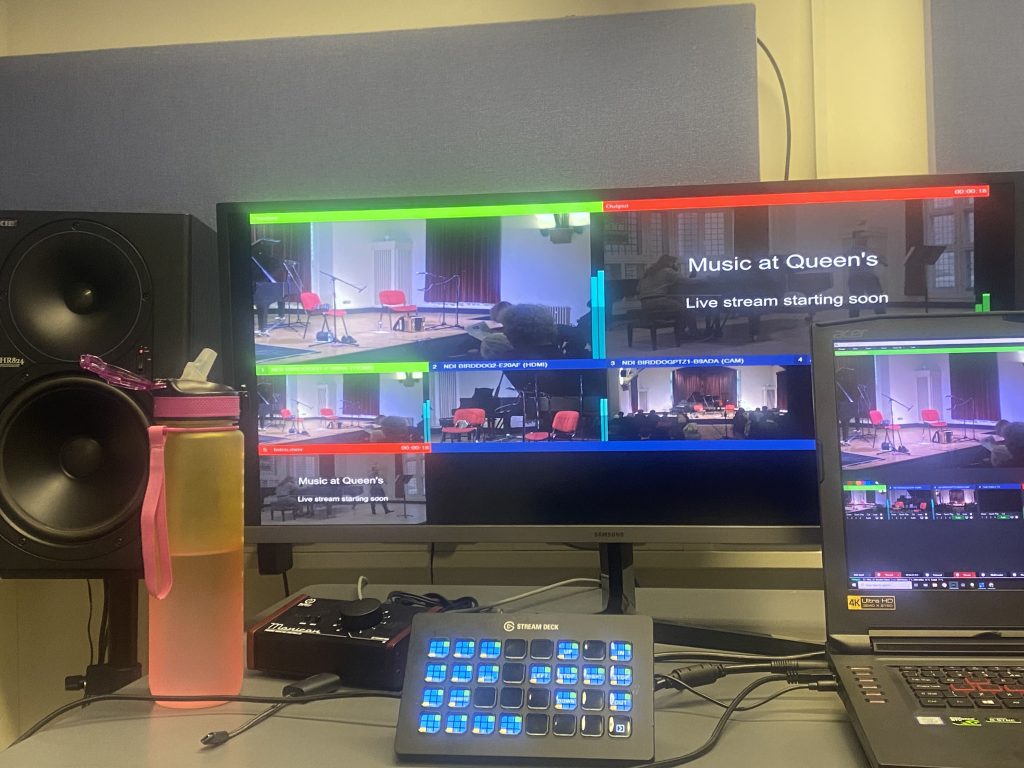by Lia Harvey
For this module, I have secured my placement with the Video Team in Queen’s University’s Sonic Arts Research Centre (SARC), which I attend for 4 hours every Thursday. My role in this placement involves livestreaming lunchtime concerts held either in the Sonic Lab in SARC or in the Harty Room located in the Music Building at Queen’s to be livestreamed on YouTube. The tasks involved in my placement include physical and remote camera operation, vision mixing, directing, as well as troubleshooting the inevitable technical difficulties that can and will happen when dealing with technology and equipment.

I am currently still quite unsure of what career path I hope to go down, but the main areas that interest me in the broadcasting industry would be camera operation, lighting, scriptwriting and cinematography, particularly with live TV or documentary making. Prior to starting university, I completed an A-Level in Moving Image Arts as well as a Level 2 course with the BFI in ‘Preparing to Work in the Film Industry.’ Additionally, I completed BCP2003 last year where as a group of 15, we broadcast a live television programme where the software that I’m currently using in placement was introduced to me. As I am able to transfer previously learned skills over to my placement, this has vastly improved my confidence when using the software and equipment required.
In the first week of my placement, we were given some basic safety training when setting up for recording concerts. Thankfully, there were only two general rules of thumb – don’t block the fire exits and ensure that no one can trip on the wires from our setup. This is vital to ensure the safety of the concert’s audience, performers and any others in the room and to prevent injury or damage to the equipment.
I have spent my time in placement learning about how to set up a livestream using software such as vMix and BirdDog Camera Control as well as using the opportunity to meet new people. My colleagues in placement are other Broadcast and Film students that I get on with well, which has had a very positive effect upon my enjoyment of placement.


I have chosen to reflect upon my experience in placement by using Gibbs’ Reflective Cycle. I feel that this model of reflection would be the most beneficial when thinking upon alternative courses of action in future when I may come across similar situations. It clearly provides detailed stages of how to properly reflect upon difficult moments and how to improve oneself. Additionally, it will allow me to continue learning while I am working, as mistakes and difficult scenarios will be commonplace, I will need to know how to handle them as best as I possibly can in order to be successful.
McMillan writes that “The cyclical nature of the process occurs when the outcome of a prior cycle of reflection informs your actions in the next similar event. This is commonplace in university where the educational process involves building on past learning and developing skills.”[1]

Description
A couple of weeks ago, there were only three members of the team present for one of our broadcasts of a violin ensemble. My two colleagues agreed to do the necessary camera operation on the floor, whilst I had to take on the role of vision mixer, remote camera operator and producer all at once! I was alone in the control room with the camera operators being unable to communicate back to me – I would only be able to relay instructions to them. Of course, because I clearly didn’t have enough to worry about as the broadcast started, two of the buttons on the Stream Deck were mixed up; with the Camera 1 button being connected to Camera 2 and vice-versa. Thankfully, one of the SARC technicians that supervises the student teams had entered the room to check on me knowing I was alone, and helped me out by placing masking tape on the Stream Deck to correctly label the buttons. I was able to complete the live stream in the end, however I felt very anxious throughout about juggling all of these tasks at once whilst being live.

Feelings
I was feeling very confused and stressed initially during the live broadcast, due to the amount of tasks I was responsible for and the added pressure of being live in front of the several viewers who were currently watching the livestream. My thoughts were focused on trying to get through the 50 minute long livestream successfully so that the viewers would be provided with a professional quality livestream, providing the standard that Queen’s would expect from content representing the university. There was pressure on my shoulders to ensure that everything would go smoothly, however I had decided to view it as a challenge that I should persevere through. I felt very happy with the outcome, and looking back I am proud of my ability to cope in situations like these which normally could prove to be overwhelming.

Evaluation
The experience was quite difficult yet rewarding. On one hand, especially on the surface, it was a stressful and challenging experience because I had felt the pressure of knowing how if I were to make a mistake, our viewers would have seen it as well as the SARC technicians. Even though they would be very forgiving towards me if I had made a mistake, I still wanted to ensure that the streaming went well because I wanted to prove to myself and others that I am capable of working under pressure in difficult circumstances – if I can handle working in retail on Christmas Eve, I can handle just about anything. For me, the most significant element of this situation arose from my ability to power through something that could have caused me to shut down from distress, which demonstrates my determination to persevere through difficulty which can arise at any moment in my practice. This has been an unintended positive aspect of that situation as I am able to reaffirm my abilities, overall this has improved my self-confidence which is an essential trait for my practice and future career.
Analysis
This situation has shown me the importance of asking for help – if I had never expressed to the SARC technician about the difficulty I was facing, I likely would have been struggling throughout the livestream. “Although the experience itself was negative, the use of Gibbs’s cycle enabled her to see the incident in a different way and turn it into a learning experience.” (Jasper 84) [2] This quote is useful to my analysis of the situation because it clearly lays out a positive aspect of using Gibbs’ model, which is how it allows me to consistently get some use out of bad situations by using it to improve upon myself. Despite how overwhelmed I had felt during this situation, using this reflective model has given me the opportunity to grow from the incident as something I can learn from in my future practice. If I were to go down the path of working in live television as a career, I will be prepared to handle any of the sudden challenges that can be thrown my way while on the job.
Conclusion
I realise now that to prevent this from happening, I should have had a better understanding of mapping buttons to the Stream Deck properly. This could have prevented the need for help in the first place, and reduced stress entirely without an oversight in the functions of the buttons. A small oversight such as this can cause a lot of problems in the long run, which highlights the importance of double-checking that everything is functioning properly. To improve upon my knowledge of software and equipment that will be utilised in my career, I should source out tutorials in my free time and ask for demonstrations and explanations from my colleagues or the SARC technicians whenever convenient. Furthermore, when I am dealing with reduced team sizes, I should prepare myself for additional strain upon production, as sickness and emergencies can occur without warning as part of general life.
Action Plan
If this kind of situation arose again, the first thing I would do is ask for help, whether it be from a supervisor or my colleagues. This is because in my situation, this was the difference between what could have been success or failure. Additionally, I would take extra care to ensure that everything is working correctly beforehand, which can be done with extra practice using the software to further familiarise myself with it.

Bibliography
[1] McMillan, Kathleen, and Jonathan Weyers. How to Improve Your Critical Thinking & Reflective Skills. Harlow: Pearson, 2013. p. 34
[2] Jasper, Melanie. Beginning Reflective Practice. Cengage Learning, 2013. p. 84